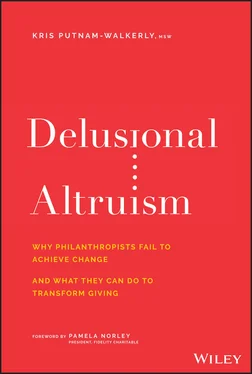However, she didn't know her baseline. She had no idea how much money her members were already donating to progressive causes. Nor did she know how much influence her organization currently had on her members' giving priorities.
She had a vision for her organization's desired future state, but no idea about its current state. Therefore, it was impossible to create a plan to move forward. When I suggested she conduct research to understand their current baseline, she balked. “No, we're just a small nonprofit. We really can't afford it,” she insisted. Instead, she asked her staff—who were already working overtime and lacked research expertise—to figure it out on their own.
In other words, she was unwilling to make an investment in something of strategic importance to the organization, because she felt her organization was “just a small nonprofit.”
Remember, her membership organization is comprised of high-net-worth donors who saw the value in this organization's work. They paid to be members! The wealth was sitting right there. But she wasn't willing to ask any of them to support this project. I'm sure one of her members would have been delighted to fund a research project that would help more philanthropists donate to progressive causes. But her scarcity mentality held her back and stifled her organization's philanthropic impact.
Now that we've discussed the guises a scarcity mentality takes in your mind, let's look at how it shows up in philanthropists' lack of investment.
Lack of Investment in Your Own Talent
Too often funders refuse to invest in the human capital of philanthropy. They think they're saving money, but they're shooting themselves in the foot.
Philanthropy is comprised of people. Donors are people. Family offices are run by people. Foundations are nonprofit organizations staffed by people. When we need legal, financial, and coaching help, we retain people. And the people we want to help are, well, people!
Given philanthropy's people-centeredness, the lack of investment in people is stunning.
What do I mean by investing in people? I mean investing in you . You—the person reading this book. And the people who help you with your giving. This could be your board of directors, your employees, your boss, your kids, or your spouse. I'm referring to bringing on the best talent to help you start, design, grow, manage, assess, and scale your philanthropy to achieve maximum impact. I also mean providing them with the resources and support they need to be their best selves and contribute their talents. After all, you want to change the world.
Sadly, this often does not happen. Most well-intentioned philanthropists don't invest in themselves.
Let me share a few examples.
One former professional football player started a nonprofit foundation to give back to his community. He created football camps and tutoring programs to offer low-income kids an opportunity to learn a sport, gain teamwork skills, have positive role models, and increase their educational opportunities. Although he made significant financial contributions, he knew he needed to raise additional funds to scale and sustain these programs.
Like most people, he lacked fundraising experience. He didn't know the best way to raise money. He and his wife tried, but their efforts didn't result in large contributions. Yet he refused to hire a fundraising consultant or grant writer. Why? It would cost money! You can guess what happened. He was able to maintain terrific camps and tutoring for a small number of kids, but he couldn't realize his vision of helping greater numbers.
In Africa, a multifamily office hired a talented nonprofit leader to serve as its first director of philanthropy. His job was to help the families become more philanthropic. The thing was, though, that while he had excellent leadership skills, he didn't have much knowledge about philanthropy. The family office leadership knew that from the outset, but they just assumed he'd figure it out. They refused to provide him with any professional development or coaching to boost her knowledge and expertise. Without any specialized information and support, the new leader quickly became overwhelmed.
A new health foundation was created following the purchase of a nonprofit hospital by a for-profit hospital. Overnight, the hospital board of directors became the foundation board of directors. The board hired a chief executive officer but refused to allow her to hire any additional staff. The CEO was expected to develop the foundation's strategy, navigate the board through politically charged local issues, create new partnerships, and grow the foundation. But she was also required to personally proofread, photocopy, and collate meeting materials; find and schedule the caterer; take meeting minutes; and handle the bookkeeping.
Bookkeeping is important. And everyone likes to eat food at meetings. But you want your leaders driving the train, not shoveling coal into the furnace. The problem here is that the board refused to invest in any additional staff—not even a virtual assistant or part-time bookkeeper—to handle the back-office work so that the foundation leader could lead. As a result, the CEO spent nearly three-quarters of her time doing administrative tasks. That's time not spent building relationships, assessing community needs, planning, or thinking. Not surprisingly, she was frustrated. A year later, she was secretly looking for a new job.
Hiring the right talent and positioning that talent for success is critical. Unfortunately, all types of philanthropists fall prey to a scarcity mentality that holds them back. Lisa McLeod, author of Leading with Noble Purpose , explains:
Many corporate leaders make the mistake of not putting a power player in charge of corporate philanthropy. They hire lower-level, less expensive employees for this role. This sends a message that philanthropy is not important. It also results in less effective philanthropic impact. If businesses want to give in meaningful ways, they should invest in philanthropy leaders who have both the positional authority and personal authority to make a difference. 1
Not every region of the world is equally positioned to invest in philanthropic talent. In Russia, for example, the philanthropic sector has few people with appropriate degrees, and there is no systemic training in the management of nongovernmental organizations. “In general, the [philanthropic] sector offers lower financial remuneration than the business sector,” explains Oksana Oracheva, executive director of the Vladimir Potanin Foundation. “Few foundations offer competitive salaries; the best-paid positions (at the program officer level) are within the US$3,000–US$5,000 per month salary range.” 2 Some effort is under way to offer nonfinancial benefits, such as extra days off, flexible work schedules, conference participation, and special recognition awards, to attract and retain top talent. Unfortunately, these efforts are not used systematically, and it's still difficult to attract people with the right skills.
Lack of Investment in Your Own Capacity
A scarcity mentality holds philanthropists back from investing in themselves in other ways. This includes a lack of investment in research, organizational learning, operations, infrastructure, and innovation.
One couple wanted to spend $1 million to reform public education across a 12-state region of the United States. On one hand, a million dollars is a lot of money. On the other hand, it would cover the salary of about 16 teachers. For one year. It's hard to reform public education by hiring 16 teachers for a one-year gig.
Unfortunately, this couple was not willing to invest the time and resources necessary to learn about the strengths and challenges of public education, best practices in education reform, or ways it could realistically make an impact with this level of investment. Nor were they interested in exploring how they could leverage their million dollars by partnering with existing education reform efforts. They wanted all their funds to support education. While noble in its intent, this approach would not help them reach their goal.
Читать дальше












